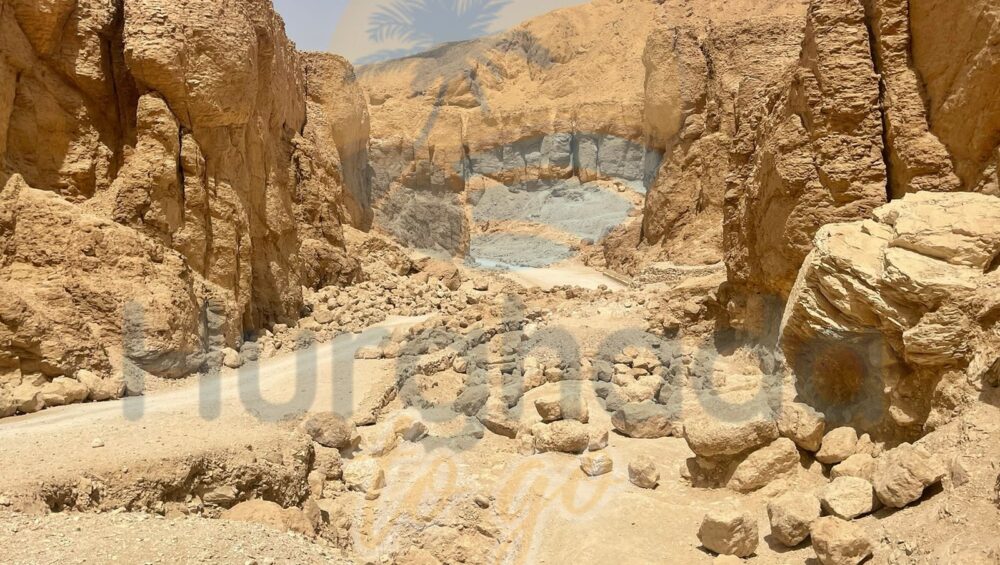The Tomb of Ay (WV23)
The Tomb of Ay, designated as WV23 (also sometimes referred to as KV23), is a royal burial site from ancient Egypt’s 18th Dynasty, located in the Western Valley of the Kings on the west bank of the Nile in Luxor. This lesser-visited gem offers a serene contrast to the more crowded main Valley of the Kings, with stunning desert landscapes and unique artistic elements that provide insight into the turbulent end of the Amarna Period.
Historical Background
Ay (reigned c. 1323–1319 BCE) was a high-ranking official who rose to become vizier under Tutankhamun before succeeding him as pharaoh. His short rule of about four years marked the final phase of the 18th Dynasty, bridging the post-Amarna restoration and the reign of Horemheb. Ay’s tomb was likely originally intended for Tutankhamun, who died young and was instead buried in the modest KV62. The tomb’s design echoes the royal tomb of Akhenaten at Amarna, featuring a straight descending axis rather than the bent corridors typical of earlier 18th Dynasty tombs.
Discovered in 1816 by Italian explorer Giovanni Battista Belzoni, the tomb was already heavily damaged—plundered in antiquity, with Ay’s name and images systematically erased, possibly by his successor Horemheb to legitimize his own rule. Ay’s mummy was never found, and the burial appears modest, lacking typical royal accoutrements like canopic chests, ushabtis, or gilded shrines. The red granite sarcophagus, smashed in ancient times, was reconstructed and reinstalled in 1994, though in reverse orientation.
Location and Access
- Site: Western Valley (also called the Valley of the Monkeys or Wadi al-Gurud), a branch off the main Valley of the Kings entrance. It’s about a 2 km (1.2 mile) dirt road hike from the Valley of the Kings parking area, past dramatic sheer cliffs—many visitors recommend walking for the breathtaking views rather than taking a taxi.
- Tickets: Requires a separate ticket (around 100–200 EGP, subject to change) from the Valley of the Kings ticket office. It’s not included in standard Valley tickets.
- Visiting Tips: Open daily from 6 AM to 5 PM (last entry 4 PM); best visited early to avoid heat. The path can be steep and dusty—wear sturdy shoes. As of October 2025, the tomb is open and undergoing ongoing restoration, but no major closures are reported (unlike the nearby WV22 of Amenhotep III, which reopened on October 4, 2025, after 20 years).

Tomb Layout and Features
The tomb is compact and linear, spanning about 100 meters, with only the burial chamber decorated. Its architecture includes:
- Entryway (A): Leads to descending corridors (B and D) separated by a staircase (C).
- Well Chamber (E): A square, undecorated vestibule with no vertical shaft (unusual for the period), opening directly into the burial chamber.
- Burial Chamber (J): The highlight—a large rectangular room (about 5m x 7m) with vivid wall paintings in a style similar to Tutankhamun’s tomb, using the same post-Amarna color palette (ochre, blue, and green).
Key decorations include:
- Unique Scenes: On the east wall, rare depictions for a royal tomb show Ay and his wife Tiy (or Teye) hunting hippos with harpoons and fowling in papyrus marshes with ducks—scenes typically reserved for noble tombs, symbolizing protection against chaos.
- Baboons Panel: A standout on the west wall: 12 baboons representing the hours of the night, welcoming the sun god’s rebirth. This inspired the valley’s “Monkeys” nickname.
- Underworld Themes: Excerpts from the Amduat (Book of What is in the Underworld) and Book of Gates, with Ay greeting deities like Nut, Osiris, Hathor, and a scarab-headed Khepri in a solar barque. The upper registers feature celestial elements, while lower ones depict the king’s ritual offerings.
The overall scheme is simpler than grander tombs like KV9 (Ramesses VI), but the intimacy and artistry make it a favorite among Egypt enthusiasts.
Why Visit?
Tomb WV23 stands out for its isolation, evoking the eerie silence of ancient burials, and its “hidden” feel—few tour groups include it, so you might have it to yourself. It’s a quick 20–30 minute visit but packs historical punch, especially if you’re exploring Amarna-era connections. Combine it with a hike through the valley for panoramic Luxor views.
For more visuals or guided tours, check resources like the Theban Mapping Project or local operators in Luxor. If you’re planning a trip, Luxor’s west bank is best explored over a full day, starting with the Valleys of the Kings and Queens.
Details on Ay’s Amarna connections
Ay, a prominent figure of Egypt’s 18th Dynasty, had deep ties to the Amarna Period, a transformative and controversial era under Pharaoh Akhenaten (c. 1353–1336 BCE), marked by the worship of the sun disk Aten and the temporary shift of Egypt’s capital to Akhetaten (modern Amarna). Ay’s connections to this period shaped his career, relationships, and legacy, including his tomb (WV23) in Luxor’s Western Valley of the Kings. Below are detailed insights into his Amarna connections, focusing on his roles, family ties, and influence.
1. Background and Role in the Amarna Period
Ay, often called the “Divine Father” or “God’s Father” in inscriptions, was a high-ranking official before becoming pharaoh (c. 1323–1319 BCE). His career began under Amenhotep III and flourished during Akhenaten’s reign. Key points:
- Titles and Status: Ay held titles like “Overseer of All the Horses of His Majesty” (a top military role) and “Fan-Bearer on the Right Hand of the King,” indicating close proximity to Akhenaten. These roles suggest he was a trusted advisor and military leader during the Amarna Period’s radical religious and political shifts.
- Amarna Loyalty: Ay’s prominence grew in Akhetaten, where he likely managed administrative or military affairs. His ability to navigate the Atenist revolution—when Akhenaten suppressed traditional gods like Amun in favor of the Aten—shows his political adaptability.
- Post-Amarna Transition: After Akhenaten’s death and the collapse of Atenism, Ay played a key role in restoring traditional Egyptian religion under Tutankhamun. As vizier or senior advisor, he likely influenced Tutankhamun’s decrees (e.g., the Restoration Stela) to reinstate Amun’s cult and move the capital back to Thebes.
2. Family Connections to the Amarna Royal Family
Ay’s familial ties to Akhenaten’s court are central to his Amarna connections, though some details remain debated among Egyptologists. Evidence comes from inscriptions, reliefs, and tombs at Amarna:
- Wife: Tiy (or Tey/Teye): Ay’s wife, depicted in his Amarna tomb (TA25) and WV23, was a high-status figure titled “Nurse of the Great King’s Wife Nefertiti.” This suggests Tiy was closely linked to Nefertiti, possibly as a wet nurse or confidante, cementing Ay’s ties to the royal family.
- Possible Relation to Nefertiti: Some scholars hypothesize Ay was Nefertiti’s father or uncle, based on his title “God’s Father,” which could imply a familial role (e.g., father-in-law to Akhenaten). However, this is not definitive, as the title might be honorific. No direct evidence confirms Nefertiti as Ay’s daughter, but her prominence aligns with Ay’s high status.
- Yuya and Tjuyu: Ay is widely believed to be the son or close relative of Yuya and Tjuyu, powerful nobles under Amenhotep III whose tomb (KV46) was found intact. Yuya, a military official, and Tjuyu, a priestess, were likely parents of Queen Tiye (Akhenaten’s mother). If Ay was their son, he would be Tiye’s brother, making him Akhenaten’s father-in-law (via Nefertiti) or brother-in-law, further embedding him in the Amarna elite.
- Nakhtmin: A general named Nakhtmin, possibly Ay’s son, was a prominent figure in Tutankhamun’s court, inheriting Ay’s military influence. Nakhtmin’s tomb at Amarna (partially erased) and his shabtis dedicated to Tutankhamun reinforce Ay’s dynastic connections.
3. Amarna Tomb (TA25)
Ay’s tomb at Akhetaten (TA25, Southern Tombs, Amarna) is a critical link to the Amarna Period:
- Design and Purpose: Built during Akhenaten’s reign, TA25 was one of the largest non-royal tombs at Amarna, reflecting Ay’s wealth and status. It was intended for Ay and Tiy but never used, as Ay later became pharaoh and was buried in WV23.
- Decorations: The tomb features Atenist iconography, including Ay and Tiy worshipping the Aten with Akhenaten and Nefertiti. A famous hymn to the Aten, attributed to Ay, is inscribed here, echoing Akhenaten’s theology. Scenes also depict Ay receiving honors (gold collars) from the royal couple, underscoring his favor.
- Abandonment: After Akhetaten’s fall, the tomb was left incomplete, with signs of defacement (likely by Horemheb’s agents, targeting Amarna figures). Ay’s shift to Thebes and burial in WV23 reflect his adaptation to the post-Amarna restoration.
4. Influence on Tutankhamun and Succession
Ay’s Amarna connections directly influenced his role during and after Tutankhamun’s reign:
- Tutankhamun’s Reign: As a senior advisor (possibly vizier), Ay likely guided the young Tutankhamun (c. 1332–1323 BCE) in reversing Akhenaten’s reforms. His Amarna experience made him a pragmatic leader, balancing old elites (Amun priests) with surviving Amarna loyalists.
- Succession to the Throne: After Tutankhamun’s death, Ay became pharaoh, possibly by marrying Ankhesenamun, Tutankhamun’s widow (and Akhenaten’s daughter). A ring bearing Ay and Ankhesenamun’s cartouches suggests this political marriage, though her fate is unclear. Ay’s Amarna ties—especially to Nefertiti’s circle—likely bolstered his claim over rivals like Horemheb.
- Tomb Evidence: WV23’s design, with its straight axis and Amarna-style art (e.g., vivid colors, baboon motifs, marsh scenes), mirrors Akhenaten’s tomb (TA26) and Tutankhamun’s KV62. This suggests Ay deliberately evoked Amarna aesthetics, even as he embraced Theban traditions.
5. Legacy and Erasure
Ay’s Amarna connections made him a target after his death:
- Horemheb’s Damnatio Memoriae: Horemheb, Ay’s successor, systematically erased Ay’s name and images in WV23 and other monuments, likely to discredit Amarna-associated rulers and legitimize his own reign. This mirrors the erasure of Akhenaten and Tutankhamun, tying Ay to their controversial legacy.
- Historical Perception: Ay’s brief reign and Amarna ties left him as a transitional figure, often overshadowed by Tutankhamun’s fame or Horemheb’s reforms. His tomb’s modest state (no mummy, smashed sarcophagus) reflects this posthumous rejection.
6. Archaeological and Cultural Insights
- Amarna Letters: These diplomatic correspondences from Akhenaten’s reign mention officials like Ay indirectly (through titles like “Fan-Bearer”), hinting at his role in foreign affairs.
- Artistic Legacy: The Amarna Period’s naturalistic art style (e.g., fluid figures, vibrant colors) persists in WV23’s paintings, like the hippo-hunting scene or baboon panel, linking Ay’s tomb to Akhenaten’s aesthetic innovations.
- Current Research: Ongoing studies (as of October 2025) at Amarna and Luxor, including 3D mapping by the Theban Mapping Project, continue to clarify Ay’s role. No major new discoveries about Ay have been reported recently, but restoration work in the Western Valley keeps WV23 accessible.

Why It Matters
Ay’s Amarna connections reveal him as a survivor of one of Egypt’s most radical periods. His ability to thrive under Akhenaten, guide Tutankhamun, and seize the throne reflects political acumen rooted in his Amarna ties. For visitors to WV23, the tomb’s art and layout offer a tangible link to this era, blending Amarna’s revolutionary style with Theban tradition. Exploring TA25’s ruins at Amarna or related artifacts in Cairo’s Egyptian Museum (e.g., Yuya and Tjuyu’s burial goods) can deepen understanding of Ay’s world.
For further study, check the Theban Mapping Project’s WV23 documentation or Amarna Project updates. If you’re in Luxor, a guided tour with an Egyptologist can highlight Ay’s Amarna connections in context.
Nefertiti’s family ties to Ay
The family ties between Nefertiti and Ay, a key figure of Egypt’s 18th Dynasty and later pharaoh (c. 1323–1319 BCE), are a subject of significant interest and debate among Egyptologists. While no definitive evidence confirms their exact relationship, inscriptions, tomb art, and historical context suggest close connections, likely familial, tying Nefertiti to Ay and the Amarna Period’s elite. Below is a detailed exploration of these ties, focusing on evidence, hypotheses, and their implications.
1. Primary Evidence for Nefertiti’s Ties to Ay
Several sources provide clues about Nefertiti’s relationship to Ay, primarily from inscriptions and archaeological finds in Amarna and Thebes:
- Ay’s Titles: Ay is frequently called “God’s Father” (or “Divine Father”) in inscriptions, notably in his Amarna tomb (TA25) and on monuments. This title could imply a familial relationship with the pharaoh (e.g., father-in-law, stepfather) or a high honorific role as a close advisor. Many scholars interpret it as suggesting Ay was Nefertiti’s father or a close relative, given his prominence in Akhenaten’s court.
- Tiy (Tey/Teye), Ay’s Wife: Ay’s wife, depicted alongside him in TA25 and WV23 (his Theban tomb), held the title “Nurse of the Great King’s Wife Nefertiti.” This indicates Tiy was intimately connected to Nefertiti, possibly as her wet nurse, foster mother, or biological mother. The title suggests Tiy played a significant role in Nefertiti’s upbringing, strengthening the link between Ay’s household and the queen.
- Amarna Tomb (TA25): In Ay’s Amarna tomb, reliefs show him and Tiy receiving honors from Akhenaten and Nefertiti, emphasizing their closeness to the royal couple. The prominence of Nefertiti in these scenes, coupled with Tiy’s title, hints at a familial bond.
- Yuya and Tjuyu Connection: Ay is widely believed to be the son or close relative of Yuya and Tjuyu, influential nobles under Amenhotep III whose tomb (KV46) was found intact in the Valley of the Kings. Yuya and Tjuyu are often identified as the parents of Queen Tiye, Akhenaten’s mother. If Ay was their son, he would be Tiye’s brother, potentially making him Nefertiti’s father or uncle, depending on her parentage.
2. Hypotheses on Nefertiti’s Parentage
Nefertiti’s origins are not explicitly documented, as her parentage is never stated in surviving records. However, several theories about her ties to Ay are based on circumstantial evidence:
- Ay as Nefertiti’s Father: The most common hypothesis posits Ay as Nefertiti’s father, with Tiy as her mother. This is supported by:
- Tiy’s role as Nefertiti’s nurse, which could reflect a maternal relationship (wet nurses were often mothers or close kin in ancient Egypt).
- Ay’s “God’s Father” title, potentially meaning “father-in-law” to Akhenaten if Nefertiti was his daughter.
- Nefertiti’s prominence in Akhenaten’s court, which aligns with her being the daughter of a powerful figure like Ay, who rose to vizier and later pharaoh.
- Ay as Nefertiti’s Brother or Uncle: If Ay was the son of Yuya and Tjuyu, and thus Queen Tiye’s brother, Nefertiti could be Ay’s daughter or niece. Some propose Nefertiti was a daughter of Yuya and Tjuyu (making her Tiye’s sister and Ay’s sister or cousin), but this is less likely, as Nefertiti was younger than Tiye and her origins seem distinct from Thebes.
- Non-Royal Origin: Nefertiti’s lack of the title “King’s Daughter” suggests she was not born to a reigning pharaoh. Her likely noble birth aligns with Ay’s family, who were not royal but held immense influence. Ay’s military and administrative roles and Tiy’s court position make them plausible parents for a future queen.
- Alternative Theories: Some Egyptologists suggest Nefertiti could be a foreign princess (e.g., from Mitanni, like Tadukhipa), but this is less supported, as her Egyptian name (“The Beautiful One Has Come”) and lack of foreign titles point to a domestic origin, likely tied to Ay’s family.
3. Implications of the Connection
Ay’s potential role as Nefertiti’s father or close kin had significant implications for his career and the Amarna Period:
- Rise to Power: If Nefertiti was Ay’s daughter, her marriage to Akhenaten (c. 1353 BCE) elevated Ay’s status, securing his role as a top official. His titles like “Overseer of All the Horses” and “Fan-Bearer” reflect this proximity to power.
- Amarna Influence: As a possible father-in-law to Akhenaten, Ay was a key figure in the Atenist revolution, managing military or administrative affairs while Nefertiti wielded unprecedented influence as Great Royal Wife. Their close ties are evident in TA25’s reliefs, where Ay and Tiy are depicted with the royal couple.
- Post-Amarna Role: After Akhenaten’s death (c. 1336 BCE), Ay’s connection to Nefertiti likely helped him maintain influence under Tutankhamun, her stepson or possible nephew. As a senior advisor, Ay guided the restoration of traditional religion, leveraging his Amarna experience.
- Pharaohship: Ay’s succession after Tutankhamun’s death (c. 1323 BCE) may have been bolstered by his ties to Nefertiti and her daughter Ankhesenamun, whom he may have married to legitimize his claim. A ring bearing Ay and Ankhesenamun’s cartouches supports this, though direct evidence is sparse.
4. Challenges and Gaps in Evidence
- Lack of Direct Proof: No inscription explicitly states “Nefertiti, daughter of Ay.” The “God’s Father” title is ambiguous, and Tiy’s nurse role could indicate a non-biological relationship (e.g., a governess or foster mother).
- Defacement: Horemheb’s systematic erasure of Amarna figures, including Ay and possibly Nefertiti, destroyed key records. For example, Ay’s name was hacked out in WV23, and Nefertiti’s later fate (post-Akhenaten) is unclear, complicating family reconstructions.
- Nefertiti’s Disappearance: Nefertiti’s role after Year 12 of Akhenaten’s reign is debated (she may have died, ruled as co-regent, or become pharaoh as Neferneferuaten). This uncertainty obscures her later ties to Ay, who outlived her.
5. Archaeological and Artistic Clues
- Tomb WV23 (Luxor): The tomb’s Amarna-style art (e.g., vivid colors, marsh scenes, baboon motifs) reflects Nefertiti’s era, suggesting Ay’s continued connection to her legacy. The depiction of Tiy in WV23 reinforces her link to Nefertiti.
- Amarna Tomb (TA25): Scenes of Ay and Tiy with Nefertiti and Akhenaten, plus the Aten hymn, tie Ay’s family to Nefertiti’s religious and cultural milieu.
- Yuya and Tjuyu’s Tomb (KV46): The wealth and prestige of Yuya and Tjuyu’s burial goods suggest a family capable of producing figures like Tiye, Ay, and possibly Nefertiti, reinforcing their elite status.
6. Current Understanding (October 2025)
As of October 2025, no new discoveries have definitively clarified Nefertiti’s parentage, but the consensus leans toward Ay and Tiy as her likely parents, based on Tiy’s nurse title and Ay’s prominence. Ongoing excavations at Amarna and studies by projects like the Theban Mapping Project continue to explore Amarna-era connections. DNA analysis of mummies (e.g., the 2010 study of Tutankhamun’s lineage) has not conclusively identified Nefertiti’s mummy, leaving her family ties reliant on textual and artistic evidence.
Conclusion
Nefertiti was likely the daughter of Ay and Tiy, or at minimum a close relative (e.g., niece or foster daughter), based on Tiy’s role as her nurse, Ay’s “God’s Father” title, and their shared prominence in Akhenaten’s court. This connection positioned Ay as a pivotal figure in the Amarna Period and its aftermath, culminating in his pharaohship and burial in WV23. For deeper exploration, visit Ay’s tomb (WV23) in Luxor’s Western Valley or study Amarna’s TA25 reliefs (accessible via virtual tours or publications like the Amarna Project). If you’re seeking specific artifacts, Cairo’s Egyptian Museum houses related items, such as Yuya and Tjuyu’s burial goods, which contextualize Ay’s family.

Easy & Secure Booking
Reserve your unforgettable Luxor day trip from Hurghada:
🌐 Official Website: hurghadatogo.com
📧 Email: [email protected]
📱 WhatsApp: +201009255585




